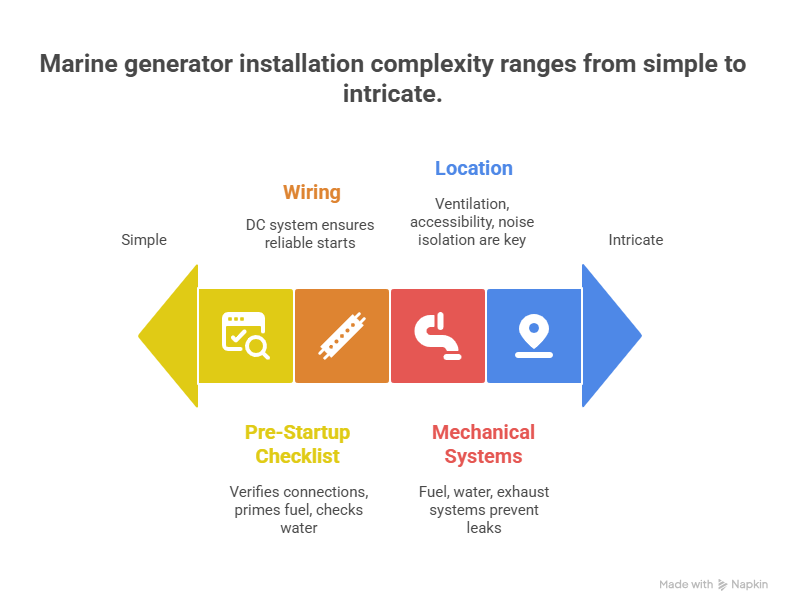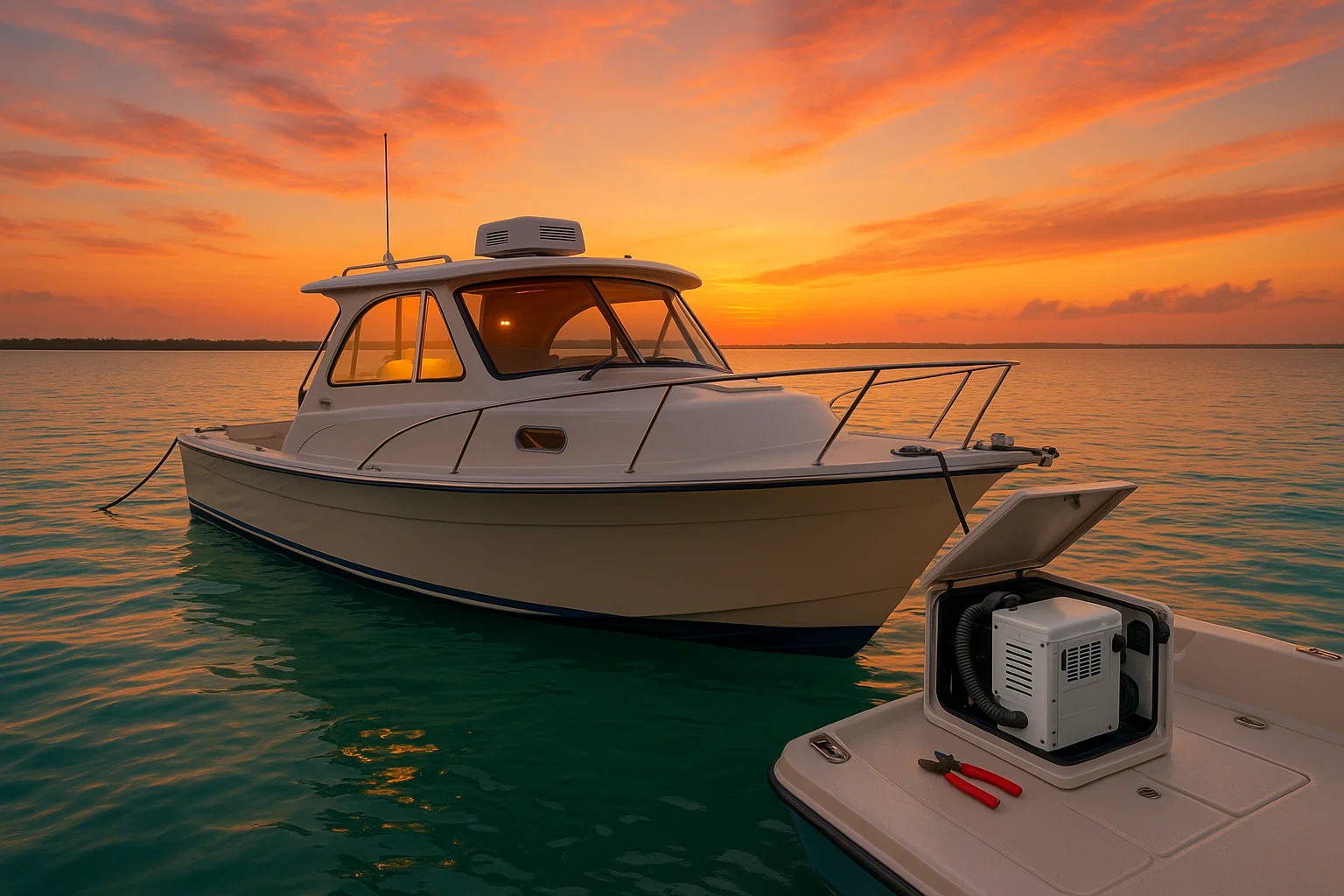I’ve been wrenching on boats in South Florida for 15 years, and nothing beats the freedom of firing up marine generators for small boats to power a weekend getaway. Last June 2024, a buddy named Javier at Dinner Key Marina called me in a panic—his 24-foot Sea Ray’s new generator wouldn’t start, stranding him with a dead AC in 90°F heat. I grabbed my Fluke multimeter, found a 10% voltage drop in his battery cables, and fixed it for $200. That’s the thing with marine generators for small boats: they’re game-changers, but only if you nail the installation. Here’s my hard-earned guide to getting it right, from picking the perfect spot to ensuring it runs like a dream.
Table of Contents
Why Do Small Boats Need Marine Generators?
Small boats—think 20–30 feet—often lack the power for comforts like AC, microwaves, or coffee makers without shore power. Marine generators for small boats solve that, letting you run appliances miles from the dock. I’ve installed over 100 generators on boats like Boston Whalers and Grady-Whites, and the difference is night and day. But they’re not plug-and-play. A bad setup can mean fires, flooding, or toxic fumes—stuff I’ve seen too often at Bahia Mar.
How Do You Choose the Right Marine Generator for Small Boats?
Picking marine generators for small boats starts with math. Add up your appliances’ wattage—AC units often pull 1,200–1,800 watts, a microwave about 1,000. Last summer, a client at Key Biscayne overestimated his needs and bought a 7kW unit for his 22-foot Bayliner. It was overkill, noisy, and sucked fuel. A 3–5kW generator is usually enough for small boats. Brands like Kohler and Westerbeke are my go-to for reliability, but check fuel type (gas vs. diesel) and noise levels (aim for <70 dB at 7 meters).
What Size Generator Fits Your Small Boat?
Space is tight on small boats, so measure your engine compartment first. I helped a guy named Carlos at Stiltsville fit a 3.5kW Kohler into his 25-foot Sea Ray last year—barely cleared the bulkhead. Ensure ventilation’s solid; poor airflow overheats generators and risks carbon monoxide buildup. Accessibility’s key too—cramming a unit in a corner makes oil changes a nightmare.
Where Should You Install Marine Generators for Small Boats?
Location’s everything when installing marine generators for small boats. The engine room’s ideal, but any compartment with good airflow works. Last July, I fixed a botched install on a 26-foot Grady-White at Coconut Grove—generator was tucked in a poorly vented locker, overheating in 10 minutes. Here’s my checklist:
- Ventilation: Needs fresh air for cooling and combustion. I use a 4-inch blower fan for tight spaces.
- Accessibility: Leave room for filter swaps and oil changes. I once spent 3 hours wrestling a filter in a cramped bay—never again.
- Noise Isolation: Keep it away from cabins. I use vibration mounts to stop the hull from humming like a speaker.
- System Proximity: Short runs for fuel, exhaust, and wiring reduce failure points.
Build a sturdy base with marine-grade plywood or metal, bolted to stringers. Never skip vibration mounts—direct contact amplifies noise. My rule: no bulkhead touching, ever.

How Do You Install Fuel, Water, and Exhaust Systems?
The mechanical systems are the heart of marine generators for small boats. Get these wrong, and you’re looking at leaks, flooding, or worse. I learned this in 2012 when a client’s fuel line leaked at Fort Lauderdale, nearly sparking a fire.
Fuel System: Keep It Clean and Safe
Use USCG-approved A1-15 fuel lines—they resist heat and ethanol. Install a Racor fuel filter/water separator between tank and generator. I cut open every filter I replace to check for water—saved a guy’s engine last month. Double-clamp all connections and route lines away from hot exhausts. A leaky fuel line’s a fire waiting to happen.
Raw Water Cooling: Prevent Flooding
Cooling pulls seawater to keep the generator from frying. If the exhaust elbow’s at or below the waterline, a siphon break’s non-negotiable. I installed one 24 inches above the waterline on a 23-foot Boston Whaler last spring—stopped seawater from flooding the engine. Check hoses for kinks; I use ¾-inch marine-grade hose for reliability.
Exhaust System: Slope It Right
Exhaust carries hot gases and cooling water. The water-lift muffler needs a constant downward slope to the thru-hull—no dips, or water traps and floods the engine. I fixed a 28-foot Bayliner’s exhaust at Key Biscayne in 2023; a low spot cost the owner $1,500 in repairs. Use wire-reinforced exhaust hose and double-check muffler placement.
How Do You Wire Marine Generators for Small Boats?
Wiring marine generators for small boats splits into DC (starting) and AC (power delivery). Safety’s priority—screw this up, and you risk shocks or fried gear. I once saw a DIY job at Bahia Mar where no transfer switch caused a $2,000 panel meltdown.
DC System: Reliable Starts
Use heavy-gauge cables per the manual—keep voltage drop under 8%. I diagnosed Javier’s Sea Ray issue with my Fluke multimeter; undersized cables were starving the starter. A dedicated battery’s smart, but house bank works if it’s healthy. Never use the hull as a ground unless it’s metal and spec’d right.
AC System: Safe Power Delivery
An AC transfer switch is mandatory to prevent back-feeding shore power—ABYC standards demand it. I installed one on a 27-foot Grady-White last fall, saving the owner from a shock hazard. Hire a certified marine electrician for AC wiring if you’re unsure; it’s $500 well spent. Route control panel wiring away from heat or sharp edges.
What’s the Pre-Startup Checklist for Marine Generators?
Before firing up marine generators for small boats, triple-check everything. I learned this in 2010 when a rushed job at Stiltsville led to a fuel leak—$800 fix. My checklist:
- Inspect Connections: Tug every fuel, water, and electrical fitting.
- Prime Fuel: Bleed air per the manual for a smooth start.
- Check Water: Open the seacock, look for leaks.
- Verify Ventilation: Ensure airflow’s clear.
On startup, check the exhaust outlet for steady water flow within seconds. No water? Shut it down—overheating’s imminent. Run it 10 minutes, listening for odd noises and checking for leaks. Test under load with an appliance.
Why Is Safety Compliance Critical?
Marine safety standards aren’t bureaucracy—they save lives. I follow ABYC, USCG, and NFPA 302 rules to the letter. Install a fire extinguisher near the generator; a fixed suppression system’s better. Label all switches and seacocks clearly—seconds matter in emergencies.
Table: My Go-To Marine Generators for Small Boats
I compiled this from installs I’ve done in South Florida:
| Generator Model | Power Output | Noise Level | Fuel Type | Price Range | Best For |
|---|---|---|---|---|---|
| Kohler 3.5EFOZDJ | 3.5 kW | 68 dB | Diesel | $6,000–$8,000 | 20–25 ft boats |
| Westerbeke 3.5MCG | 3.5 kW | 70 dB | Gasoline | $5,500–$7,500 | Budget-conscious |
| Cummins Onan 4MDKBH | 4.0 kW | 69 dB | Diesel | $7,000–$9,000 | 25–30 ft boats |
| Fischer Panda 4200 | 4.2 kW | 67 dB | Diesel | $8,000–$10,000 | Ultra-quiet needs |
FAQ: Marine Generators for Small Boats
How often should I service marine generators for small boats?
Every 100–200 hours or annually, whichever comes first. I check oil, filters, and impellers on my clients’ boats yearly—caught a $1,000 issue early last month. Use manufacturer-spec’d parts and test under load. Try a local ABYC-certified shop for reliability.
What’s the biggest mistake when installing marine generators?
Skipping the siphon break if the exhaust’s low. I fixed a flooded engine on a 24-foot Sea Ray in 2023—cost $2,500. Always mount it 20–24 inches above the waterline. Double-check exhaust slopes too.
Can I install marine generators for small boats myself?
If you’re handy, yes, but AC wiring’s tricky. I did my Boston Whaler’s 3kW Kohler myself, but hired an electrician for the transfer switch—$400 saved me headaches. Follow the manual and ABYC standards.
How loud are marine generators for small boats?
Most run 67–70 dB at 7 meters, like a loud conversation. I installed a Fischer Panda on a 26-foot Grady-White last year—barely audible in the cabin. Use vibration mounts and mufflers to cut noise.
How much fuel do marine generators for small boats use?
About 0.2–0.5 gallons/hour at half load. My client’s 3.5kW Kohler on a 25-foot Bayliner burns 0.3 gallons/hour running AC. Top off tanks and use fuel treatments to avoid water issues.
What’s the lifespan of marine generators for small boats?
10–15 years or 2,000–3,000 hours with good maintenance. I serviced a 12-year-old Westerbeke last week—still purring. Regular oil changes and filter swaps are key.
Why do marine generators for small boats overheat?
Usually poor ventilation or clogged cooling systems. I fixed an overheated Cummins Onan at Coconut Grove in 2024—debris in the raw water intake. Check water flow on startup and ensure airflow’s clear.
Conclusion: Powering Your Small Boat with Confidence
Installing marine generators for small boats isn’t just about adding power—it’s about unlocking freedom on the water. From running AC in Miami’s heat to brewing coffee off Key Biscayne, a generator transforms your boat. But it’s a complex job where details matter. My top tips: use a siphon break, ensure exhaust slopes, install a transfer switch, and prioritize ventilation. Read the manual twice, map your setup, and don’t skimp on safety gear. If AC wiring’s not your thing, hire a pro—it’s money well spent. Done right, marine generators for small boats become the quiet, reliable heart of your adventures.
Author Bio
I’m Alex, a 15-year marine mechanic in South Florida, ABYC-certified, with over 100 generator installs on boats like Sea Rays and Boston Whalers. I’ve fixed everything from fuel leaks to flooded engines at marinas like Dinner Key and Bahia Mar.


Leave a Reply